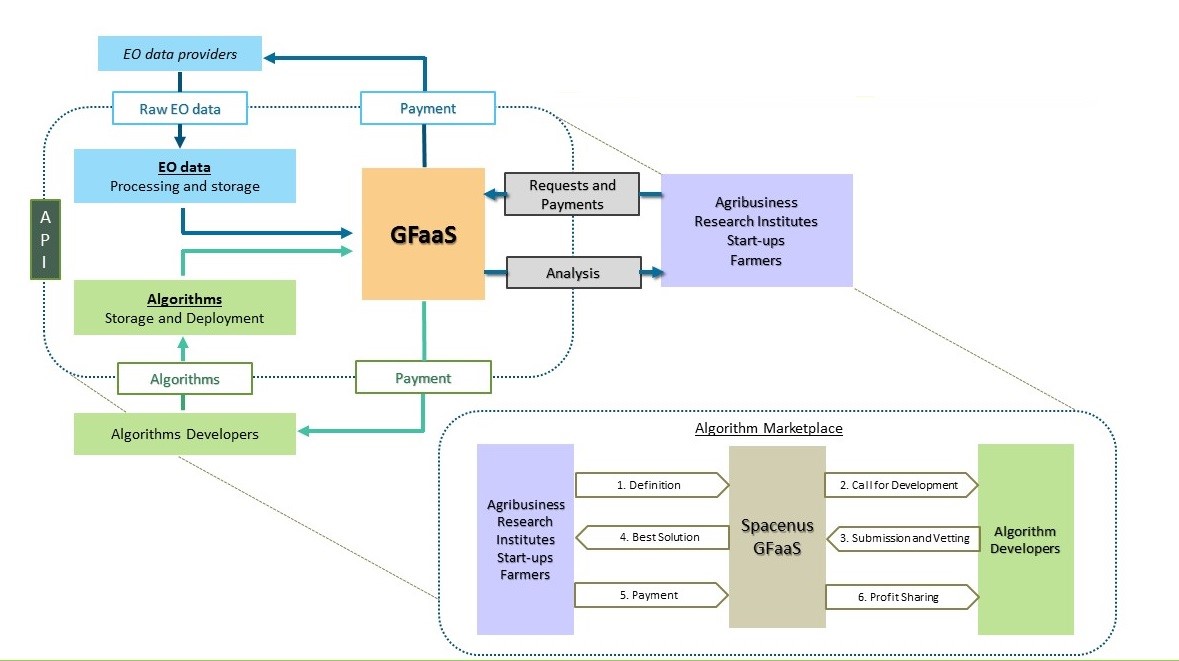
Objectives of the service
The main objective of GFaaS is ensuring painless access to satellite imagery derived information for farmers. GFaaS intends to address this issue by providing a framework platform that brings all the key players necessary for providing EO-based, easy-to-use farming solutions to farmers.
Satellite imagery contains different spectral signatures and comes in various spatiotemporal resolutions. Turning these data into agricultural recommendation information requires sophisticated data processing and assimilation solutions. Besides, for making use out of such information, farmers require other kinds of geospatial data like agricultural field boundaries, which is the basis for any kind of EO-powered agricultural applications. There are several EO service providers who take care of these critical intermediate satellite imagery processing steps and turn data into agricultural recommendations. This traditional approach makes the service price very expensive for the end-users. Again, another key constraint for accessing satellite derived information for farmers.
On the other hand, satellite imagery is considered as big data because of its variety, volume and data growth rate. These are making the EO-based solution development extremely competitive and expensive. To cope with this, we require a useful, flexible, re-useable and simple framework. With an intelligent system and framework design, GFaaS aims to address these concerns.
Users and their needs
The Farmers are the key stakeholder of GFaaS and the end-user of our API services through our paid customers’ channel. The user groups of the GFaaS will develop new Geospatial Algorithm Services (GAS), GFaaS will device the GAS as an API service and promote it among the customer groups and the paid customers will use/integrate/adopt our GAS solutions in their own service delivery portal to address the farmers’ need.
Individual geospatial developers are another user group of this platform. They will be also using this platform to answer specific questions which come from corporate industries under the framework of hackathon or challenge competition. Moreover, we have collaboration with a EU based project called Fab-Space 2.0, which is focusing on providing the EO data to the researchers and scientists.
One of our main stakeholders are EO Data Providers, who will be providing satellite data to GFaaS and by doing such they can boost their satellite imagery usages, just by connection their data APIs into the proposed platform. GFaaS will host industrial process chain to process the raw satellite data into surface reflectance’s in advance and make it available for the potential expert or non EO expert users.
We are already connected to Copernicus Data and Information Access Services (DIAS), launched by the European Commission. The DIAS platforms will provide cloud-based one-stop-shops gathering all Copernicus data, as well as data from other contributors, in one place. The platforms will also provide data processing tools for researchers and entrepreneurs interested in building products using the data. As we are using the sentinel data for our service, DIAS can act as the perfect partners. We already have had meeting with T-systems, who is the partner for communications and IT services of DIAS.

Target group of GFaaS is worldwide.
Service/ system concept
GFaaS can support the user, developers, scientist and the service require the following steps.
- Analysis, concept development and evaluate the ideas.
- prototyping and testing.
- Product development and marketing test
- commercialization
Besides, the proposed solution GFaaS can act as safeguard for the smooth shipping of their ideas into the proposed platform for commercial usages, hence addresses the solution to the big quaternions, competently. GFaaS is an easy-to-use Platform, which is powered by processed EO big data, geospatial algorithms, API portal and IT infrastructure - all hosted in a cloud fashion. The system will be highly saleable, globally available. This will also ensure the global users to have easy access to the EO data and decode the data to attend their need.

Space Added Value
GFaaS uses earth observation (EO) images from various satellites like Sentinel, Landsat, MODIS etc. for computational purposes. The imagery from EO satellites enable our platform to perform various agronomic applications like field boundary detection, produce nutrient deficiency maps, field management zone and analyse field performances.
Satellite imagery usually come as an array containing Digital Numbers (DN). To make use of this data, the DN values are converted into surface reflectance which is compulsory for spatio-temporal agricultural applications. Satellite imagery processing also involves multiple quality processing steps like atmospheric correction, image co-registration, cloud/cloud-shadow masking, etc. This processing steps are automatically done by the platform upon users’ request. Thus, GFaaS provides ready-to-use satellite data for various field-level agronomic applications.
GFaaS is specifically designed for agricultural applications and such systems requires functionality to make use of geo-tagged field data like field scouting data (i.e., soil quality, nutrient status) and get combined with EO data to generate field application maps. Working with EO and GNSS enables covering entire fields at once, which is an important factor in terms of time- and cost-efficiency, and thus in scalability.

Current Status
GFaaS project officially kicked off on 1st of December 2017. After the project started, we have met framers and agricultural consultants to understand the current situation and demand in the ecosystem of digital/precision farming products. We also established a connection to a potential partner T-Systems. With them we started understanding the offer side (industry) that is currently shaping itself for making digital farming products scalable. We have also organized two successful Hackathons with Fab-Space 2.0 as a platform for geospatial scientists, university researchers and EO algorithm developers. They also developed, tested and deployed their ideas in no time as API services using the proposed platform.
Spacenus has successful mid-term review of GFaaS on 1st of March 2018 via teleconference with ESA. This resulted in starting the implementation phase. By mid-2018 we have built up key partnerships to get access to critical market channels and by end of 2018, we will start working on the demonstration phase.



